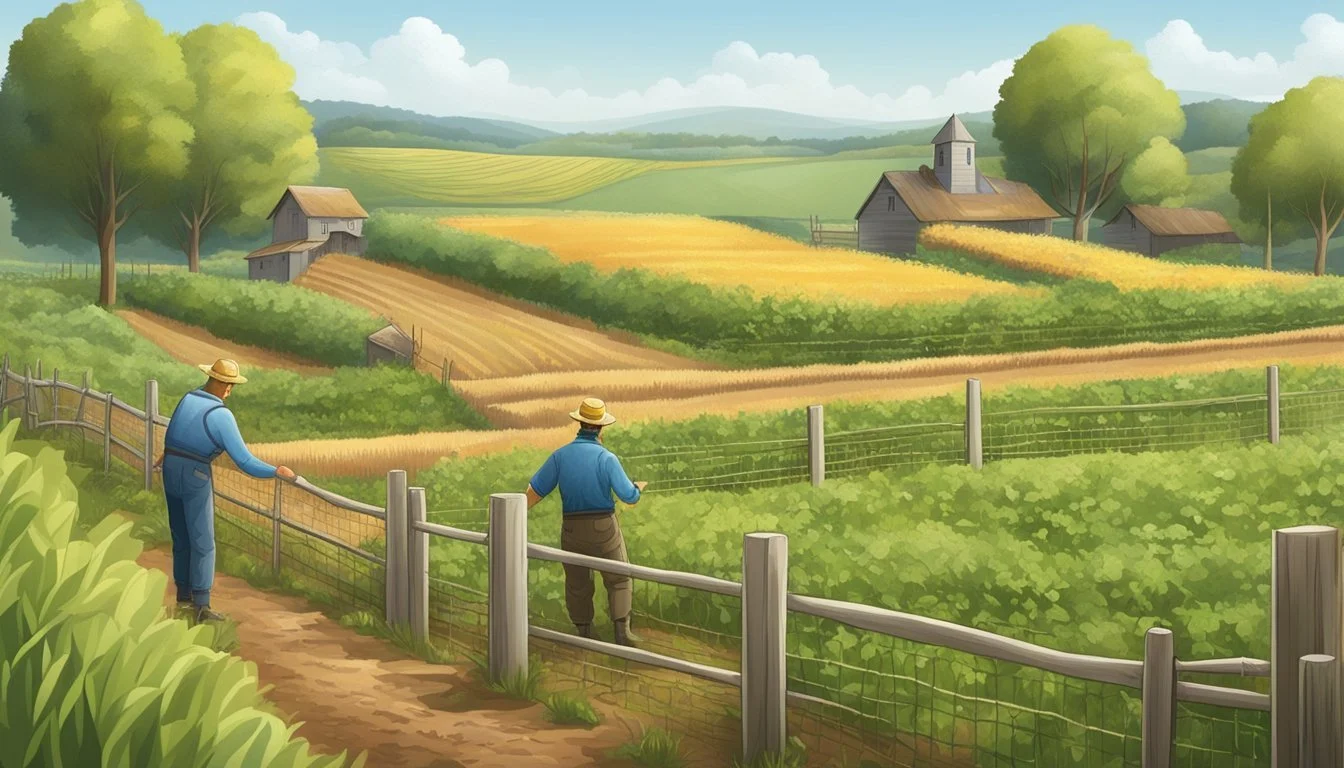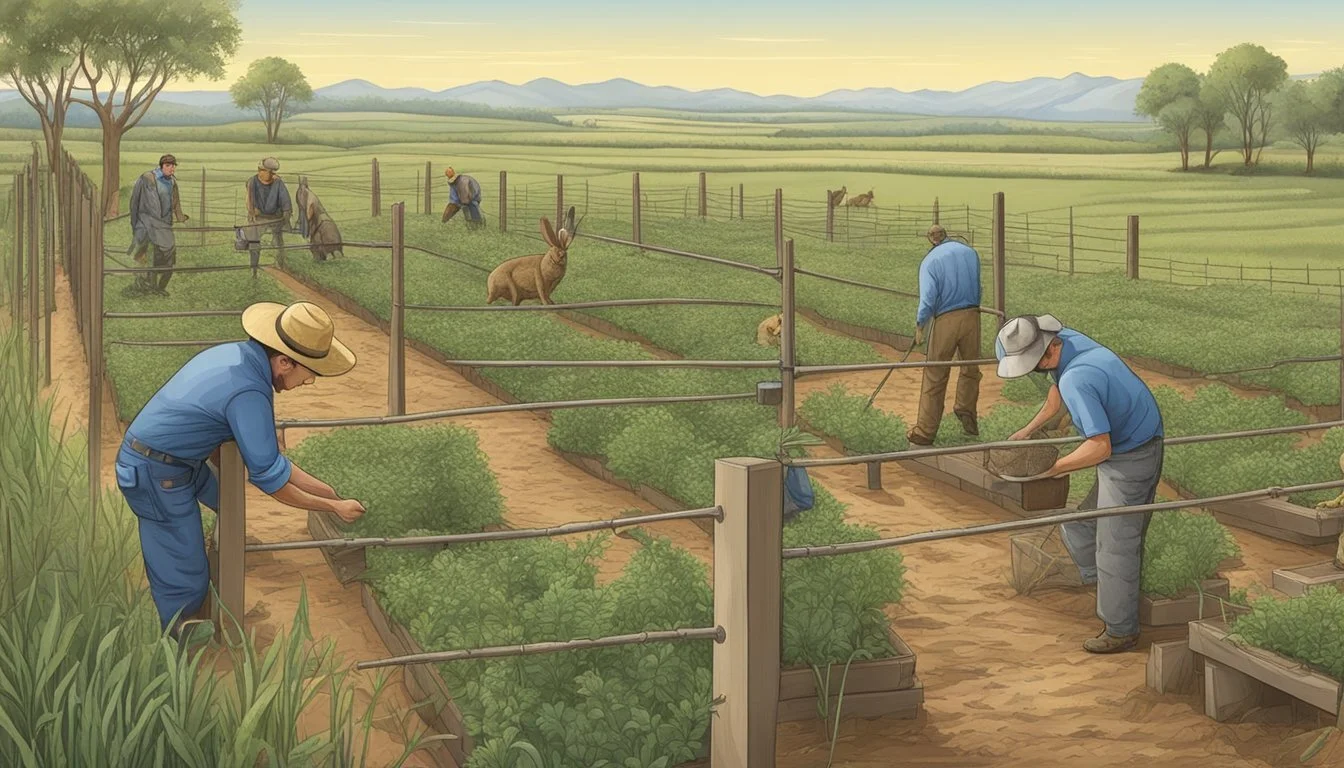Protecting Crops from European Rabbit
Effective Strategies for Farmers
European rabbits, or Oryctolagus cuniculus, have long been a presence in various ecosystems, where their burrowing and feeding habits can significantly impact plant life. These small mammals possess a remarkable ability to breed and adapt to different habitats, making them an infamous pest for gardeners and farmers alike. Protecting crops from the incessant nibbling of European rabbits requires strategic planning and the implementation of effective deterrent methods.
One enduring method is the installation of adequate fencing. Fences that are specifically designed to prevent rabbits from gaining access to gardens and fields have to be constructed with attention to height and depth; rabbits are capable climbers and diggers. Additionally, employing natural repellents can help in deterring these animals without harming them or the environment. These approaches, among others, can play a critical role in safeguarding vegetation from the pervasive threat posed by European rabbits.
Understanding the European Rabbit
The European Rabbit (Oryctolagus cuniculus) plays a complex role in its ecosystem, from its extensive distribution to its notable impact on the environment and biodiversity. This section will delve into its biology and behavior, habitat and distribution, and environmental impact.
Biology and Behavior
Oryctolagus cuniculus is known for its high reproductive rate. Females can produce several litters of 3-7 kittens each year. This rapid reproduction is a key factor in its ability to colonize and impact various ecosystems. The species is primarily crepuscular and nocturnal, feeding on a wide variety of vegetation which includes herbs, tree bark, and farmland crops.
Habitat and Distribution
The European rabbit is native to the Iberian Peninsula, including Spain and Portugal, and regions such as the Mediterranean. It has been introduced to other continents like Australia and parts of Asia. Within Europe, its habitats are diverse, ranging from Mediterranean scrublands to temperate grasslands, which allows it to thrive in a wide range of environments.
Environmental Impact
European rabbits have a significant ecological role in their native range, affecting plant diversity and soil composition through grazing and burrowing. However, their introduction to countries like Australia has led to major challenges in conservation, as their feeding habits have proved detrimental to local biodiversity. Measures have been taken to manage their populations, balancing between their ecological significance and the need to protect crops and native species.
Challenges in Agriculture
Agricultural practices face numerous challenges, notably the prevalence of crop damage due to pests such as the European rabbit. This damage has significant economic repercussions for farmers, affecting their income and necessitating measures to protect crops and pasture.
Rabbit Damage to Crops
The European rabbit (Oryctolagus cuniculus) poses a severe threat to a variety of agricultural landscapes including pastures and vineyards. These rabbits consume and trample crops leading to substantial loss. For instance, they have a marked preference for tender, young shoots, which can severely affect the growth of new plants. Researchers have found that areas rich in food availability can restrict the activities of rabbits, indicating tactical points where management could be concentrated.
Economic Impact on Farmers
Farmers bear the economic burden of rabbit damage not only through direct loss of crops but also due to the cost associated with control measures. The impact on a farmer's income can be multi-faceted, ranging from the loss of consumable crops to the additional feed required for livestock that might have otherwise grazed on now-ravaged pastures. Control costs and reduced production also contribute to the economic impact, with farmers often having to invest in fencing, repellents, and population management strategies.
Rabbit Population Control Methods
European rabbits (Oryctolagus cuniculus) can cause significant damage to crops, necessitating a variety of control methods. Rigorous management strategies need to be implemented to mitigate these effects and protect agricultural productivity.
Chemical Control
Chemical control involves the use of toxic baits, such as sodium fluoroacetate, commonly known as 1080. This poison, delivered in bait form, has been used to reduce the rabbit population effectively. However, this method requires careful handling and adherence to safety protocols to prevent unintended harm to other wildlife.
Biological Control
Biocontrol agents like the Myxoma virus, which causes myxomatosis, and Rabbit Hemorrhagic Disease (RHD) are used to manage rabbit populations. These diseases drastically lower numbers but should be employed with consideration to avoid impact on non-target species and to ensure management is sustainable.
Physical Barriers and Fencing
Implementing fencing is another effective strategy for crop protection. It involves erecting physical barriers that are designed to prevent rabbits from accessing vulnerable areas. Fences need to be buried deep enough to thwart burrowing, and maintained regularly to ensure they remain impenetrable.
Hunting and Trapping
Hunters and private landowners often use trapping and shooting as immediate and direct methods to control rabbit populations. These actions can be effective, especially when conducted systematically and as part of a broader, integrated pest management program. Coordination with local laws and regulations is necessary to facilitate ethical and legal hunting practices.
Legislation and Policy
Effective management of European rabbits necessitates adherence to established legislation and policy frameworks that ensure both crop protection and animal welfare standards are maintained. These legislative measures provide guidance and enforceable regulations for landowners and agricultural stakeholders.
Regulatory Framework
The Regulatory Framework governing the protection of crops from the European rabbit hinges on various national and international laws and policies designed to balance environmental impact, animal welfare, and agricultural needs. In the European Union, there is a recognition of the need for regulatory measures to manage rabbit populations due to their impact on agriculture and the environment. Although specific laws for the welfare of farmed rabbits exist, similar comprehensive standards for wildlife management, including rabbits, may vary by country. Regulations may include control methods that farmers and landowners are permitted to use, set during certain times of the year to align with ecological and ethical considerations.
Landowner Responsibilities
Landowner Responsibilities are key in the successful implementation of policies aimed at controlling European rabbit populations. Landowners must comply with laws regarding safety and health, both for the environment and for the rabbits. This typically includes obtaining necessary permits for culling or employing non-lethal methods of control, monitoring rabbit numbers, and implementing mitigation strategies to prevent crop damage. They are also expected to follow WA (welfare assurance) policies to ensure that any action taken to protect crops is done so with consideration to the animals' well-being. Failure to adhere to these regulations can result in legal consequences.
Rabbit Management in Diverse Ecosystems
Effective management of the European rabbit (Oryctolagus cuniculus) is crucial in maintaining the balance and biodiversity of various ecosystems. Control measures must reconcile the rabbit's ecological role with the damage it may cause to vegetation and landscapes.
Grasslands and Forests
In grassland and forest habitats, the European rabbit plays a key role as both prey and herbivore, contributing to the ecological diversity. In grasslands, they aid in seed dispersal and create microhabitats for other species through their burrowing activity. However, their tendency to graze can lead to overgrazing, necessitating controlled population measures to protect the understory vegetation and young trees in forests. Interventions include:
Habitat management: Restricting rabbit access to sensitive areas through fencing.
Natural predation: Encouraging predators to help maintain natural population control.
Population monitoring: Regularly assessing rabbit numbers to inform management strategies.
Mediterranean Ecosystems
Mediterranean ecosystems are characterized by their unique flora and fauna, with the European rabbit being a keystone species. The rabbit's digging behavior promotes soil aeration and nutrient cycling, beneficial for certain plant species. Yet, their population growth, especially in agricultural areas, can disrupt the balance, leading to land degradation. Management in these systems includes:
Integrative land use: Aligning agricultural practices with ecological needs to mitigate impact.
Selective exclusion: Utilizing protective measures for key plant species vulnerable to rabbit grazing.
Enhanced biodiversity: Ensuring a mosaic of habitats within the landscape to distribute rabbit populations and reduce pressure on specific areas.
Community Engagement and Attitudes
Effective management of European rabbit populations requires a comprehensive understanding of community engagement and attitudes towards the species. This involves both educational initiatives and collaborative efforts from various stakeholders.
Education and Awareness
The community is an integral player in the mitigation of wildlife-induced damages, specifically those caused by European rabbits. A concerted effort to enhance education about the environmental and agricultural impact of rabbits is vital. Through awareness campaigns, communities learn about the extent of the Oryctolagus cuniculus as an invasive species, its effect on local biodiversity, and the economic repercussions on agriculture.
Objectives of Education Programs:
To inform about rabbit-induced damage to crops and ecosystems.
To provide best practices for sustainable rabbit management.
Awareness strategies can transform community attitudes, fostering a sense of stewardship and responsibility for local land management.
Stakeholder Collaboration
Collaboration among stakeholders is essential to effectively address the challenges posed by the European rabbit. This includes farmers, conservationists, hunters, and government bodies. Their views are often diverse, as highlighted in a study showcasing the varied roles of rabbits in Europe.
Potential Conflicts:
Hunters may promote rabbit proliferation for sport.
Farmers typically support culling due to crop damage.
Conservationists may have concerns over ecosystem impacts.
By promoting stakeholder collaboration, it is possible to reconcile these views into a cohesive management strategy that respects both human and wildlife needs, thereby reducing the incidence of human-wildlife conflicts.
Frequently Asked Questions
Farmers and landowners often seek effective methods to protect their crops from the European rabbit. These frequently asked questions address common concerns and strategies.
How can farmers effectively deter European rabbits from damaging crops?
They can install fencing specifically designed to keep rabbits out of their property, which often involves using heavy-duty, galvanized steel mesh for secure barriers.
What are some environmentally friendly strategies for managing European rabbit populations in agricultural areas?
Land managers may implement integrated pest management strategies that include habitat modification and population control measures that are humane and environmentally sustainable.
What impact does the European rabbit have on local ecosystems and how does this relate to crop protection?
The European rabbit can cause significant land degradation by burrowing, leading to soil erosion and the loss of native plant species, which makes it crucial to address their populations for both ecological balance and crop protection.
In regions like California, what methods are used to protect agriculture from the European rabbit?
Specifically in places with a mild climate like California, methods similar to those in Europe such as exclusion fencing and population management are used to mitigate rabbit-induced crop damage.
What protective measures are available to safeguard plantations against European rabbit invasions?
For plantations, the use of tree guards, repellant plants, and strategically placed guard animals or deterrents can discourage rabbits from approaching young saplings and valuable crops.
How do natural predators contribute to controlling European rabbit populations and can this be leveraged to protect crops?
Natural predators like foxes, birds of prey, and snakes play a crucial role in controlling rabbit numbers. Encouraging the presence of these predators can be an effective, albeit indirect way to reduce rabbit populations and protect crops.








